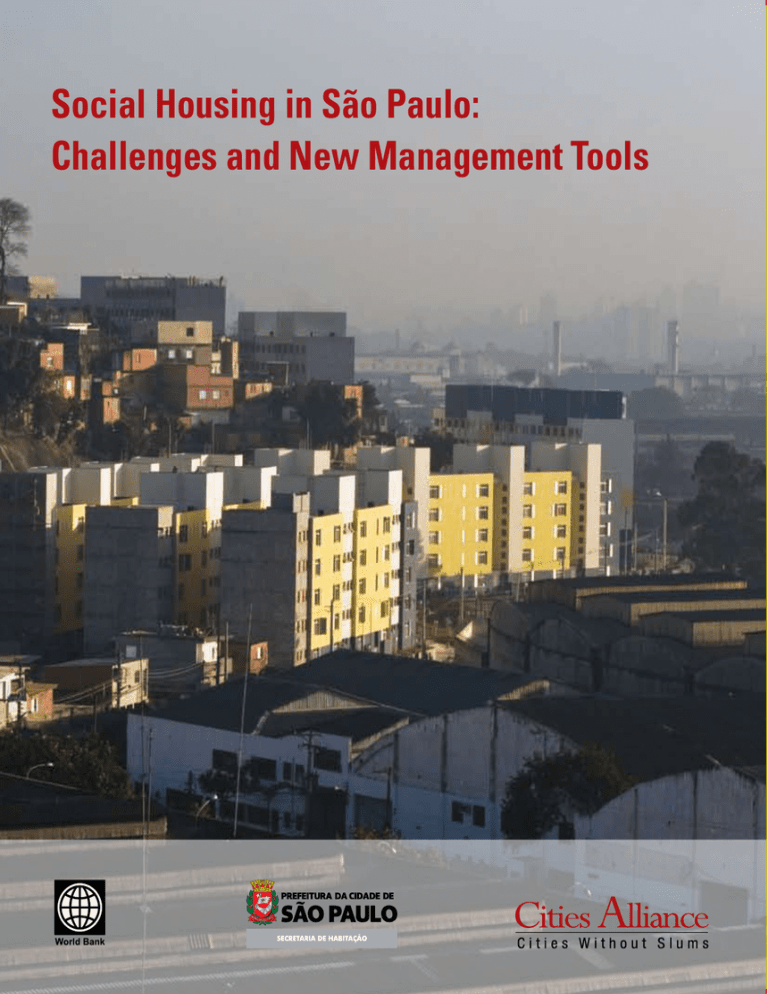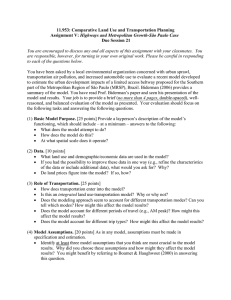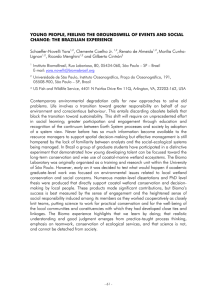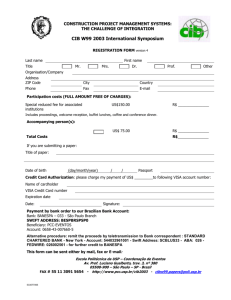Social Housing in São Paulo: Challenges and New
advertisement

Social Housing in São Paulo: Challenges and New Management Tools Social Housing in São Paulo: Challenges and New Management Tools World Bank Editorial Coordination Tereza Herling Elisabete França Text Tereza Herling Contributors to the Text Alex Abiko, Ana Paula Bruno, Elisabete França, Giorgio Romano Schutte, Ivo Imparato, Márcia Maria Fartos Terlizzi, Mariana Kara José,Violeta Saldanha Kubrusly Final Edit Anselmo Massad (Publisher, Brasil Editora) Graphic Design and Production Zoldesign - Renato Salgado, Mariana Afonso, Renata Carla Atilano Archive of Photos, Illustrations, Images, and Maps Daniel Ducci, Maria Teresa Diniz dos Santos, Robson Martins, SEHAB / HABI © The Cities Alliance, 2009 1818 H Street, NW Washington, D.C. 20433, U.S.A. http://www.citiesalliance.org/index.html All rights reserved First printing, June 2009 The material in this publication is copyrighted. Requests for permission to reproduce whole or portions of it should be directed to the Cities Alliance Secretariat at the above address. The Cities Alliance encourages the active dissemination of its knowledge. Permission to disseminate will normally be granted promptly and, when reproduction is for non-commercial purposes, without asking for a fee. Cover Photo: Nova Jaguaré Photographer: Fabio Knoll © Design: Zoldesign Printing: York Graphic Services Foreword This publication reflects the tremendous progress that São Paulo has made in becoming a city that serves all its citizens. Assisted by outstanding coordination from the World Bank, the city government of São Paulo and the Cities Alliance have had the privilege of sharing mutual technical support, with favorable results for everyone. However, it is important to emphasise that this partnership has had a significant impact on the Cities Alliance itself. Prominent among the various lessons learned is the importance of taking the long view. Doing so has ensured that this partnership could survive different city government administrations, as well as changes in leadership at the Cities Alliance. The cooperation begun in 2001 has remained stable and consistent through different city administrations and changes at the Cities Alliance, thanks to the active participation and dedication of the technical staff of SEHAB. São Paulo has become an important model for the Cities Alliance in its support for cities around the world. The city government affirmed the crucial importance of working with reliable data, supported by the kind of comprehensive system of managerial information that most cities do not yet have. São Paulo also recognised the importance of investing in a slum upgrading program and legitimising land tenure in subdivisions on a city-wide scale by appropriating substantial budgeted funds, a key component of municipal administration, year after year. Continuous support and funding from all three levels of government – local, state, and federal – demonstrate the priority given to combating urban poverty and promoting economic growth. In short, there are no secret ingredients that explain the present progress in São Paulo. On the contrary, the lessons learned come from good urban management, a stable and consistent political commitment, and active participation by the community – not in the form of demands, but as involved citizens. The Cities Alliance has furnished international assistance and served as a source of learning and shared experiences. Our investment and commitment come from the belief that São Paulo – by international standards, a city that is not poor – will gradually become enormously valuable to the efforts of Cities Alliance in lending support to other cities. We firmly believe that the best lessons are learned from cities that have found solutions to problems shared by other cities in the world. We would like to emphasise that the Cities Alliance has had inestimable support from its office at the University of São Paulo which, in turn, has benefited greatly from generous support from the Italian Government. On behalf of SEHAB and the Cities Alliance, we would like to say that we are proud to have been able to contribute to the remarkable progress made in São Paulo, and that we look forward to continuing this mutually beneficial partnership. Municipal Housing Secretariat and the Cities Alliance Abbreviations and Acronyms ABCP Brazilian Association of Portland Cement IBGE Brazilian Institute of Geography and Statistics ABRAMAT Brazilian Association of the Construction Materials Industry IDB Inter-American Development Bank IPTU Urban Property Tax MSP City of São Paulo PAC Growth Acceleration Program PAR Residential Leasing Program BAT Alto Tiete Basin BNH National Housing Bank CAIXA Federal Savings Bank CDHU Housing and Urban Development Company of the State of São Paulo CEM Center for Studies of the Metropolis COHAB Metropolitan Housing Company of São Paulo PAT- Program for Urbanizing, Regularizing and PROSANEAR Integrating Precarious Settlements PGU Project Management Unit PMSP Government of the City of São Paulo PNAD National Survey of Sample Households RESOLO Department of Regularisation of Informal Land Subdivisions EMPLASA State of São Paulo Company for Metropolitan Planning FIPE Economic Research Institute Foundation FLACMA Latin American Federation of Cities, Municipalities and Association of Local Governments MRSP São Paulo Metropolitan Region FMH Municipal Housing Fund SABESP Basic Sanitation Company of São Paulo FUNAPS Municipal Fund for Attending Residents of Substandard Housing SEADE State Data Analysis System – São Paulo SEHAB São Paulo Municipal Housing Secretariat FUNDURB Urbanisation Fund Administered by the Municipal Planning Secretariat SEMPLA São Paulo Municipal Planning Secretariat GDP Gross Domestic Product SFH Housing Finance System GTZ German Technical Cooperation SNHIS National Social Interest Housing System HABI Social Housing Authority UCLG United Cities and Local Governments HABISP Information and Prioritising Intervention Systems UNFPA United Nations Population Fund HIS Social Interest Housing UN-HABITAT United Nations Human Settlements Programme HMP Real estate social Housing ZEIS Zones of Special Social Interest Table of Contents Foreword 05 Abbreviations and Acronyms 07 Introduction 11 Chapter 1. Challenges Facing Housing Policy in the City of São Paulo 15 1.1. São Paulo’s urban expansion 18 1.2. Poverty and the cost of urban land: Formation of temporary and 24 informal settlements on the outskirts of the city The current status of housing in the city: Principal 1.3. 28 challenges Chapter 2. Partnership between the Municipality of São Paulo and the Cities Alliance 2.1. Strategic planning and the instruments of planning and 43 46 management 2.1.1. Workshops in strategic planning 47 2.1.2. The managerial information system for social housing in 48 São Paulo – HABISP 2.1.3. The intervention prioritisation system 53 2.1.4. Indicators for monitoring 59 2.2. Technical studies needed as support 60 2.2.1. Demand for housing assistance in precarious settlements 61 2.2.2. Improvement of SEHAB management capabilities 2.2.3. Financing social housing – public and private alternatives, 63 provision and improvements 69 Chapter 3. Dissemination of Results 3.1. Local Dissemination 75 3.2. International Dissemination 78 Chapter 4. Cities Alliance and São Paulo Housing Policy 4.1. 79 Technical training of teams for program planning and 83 management 83 4.2. Institutional coordination between the agents involved with housing policy and a more efficient management of resources 86 Final Comments 89 Bibliographical References 91 List of Photos and Illustrations 92 List of Tables 92 Introduction The Cities Alliance (Aliança de Cidades) has been working on technical cooperation projects 1. The first phase of the program is described in with the São Paulo Municipal Housing Secretariat (Secretaria Municipal de Habitação de São a publication entitled Intergrating the Poor: Urban Paulo, SEHAB) since 2001. This publication presents the results of the second phase of Upgrading and Land Tenure Regularisation in the City of the partnership, developed between 2005 and 2008. The goal in this latest phase was Sao Paulo, SEHAB and Aliança de Cidades, São Paulo, to establish a set of management tools that would permit the continuation of strategic 2004. 1 planning with respect to municipal housing. São Paulo is a city of contrasts, remnants of an economic development model that left – and is still leaving – part of its population excluded from the wealth that was created and the ensuing benefits. Although the city is Brazil’s wealthiest and most populous, one-third of the city’s population lives in favelas (slums) and informal land subdivisions. Combating poverty, creating jobs and generating income, reducing social inequality, and contributing to environmental sustainability are challenges intrinsic to housing policy. While the flow of internal migration resulting from the strong attraction that industrial jobs hold for residents of Brazil’s poor regions has drastically diminished and industrial enterprises are being distributed more homogenously over the nation’s territory, large numbers of poor people are still concentrated in major Brazilian metropolises such as São Paulo, Rio de Janeiro, Belo Horizonte, Salvador, and Recife. A large portion of this population, particularly the poorer segment, remains in the cities despite exclusion from a formal labour market that demands skilled labour. This problem is not restricted to today’s Brazil. It can be found in major cities of the southern hemisphere that have undergone intense urbanisation in recent years. Globally, the outlook cited by the United Nations Human Settlements Programme (UN-HABITAT) is that by 2030, the world’s urban population will have reached 5 billion, out of a total population of 8.1 billion. It is estimated that the urban population worldwide will grow at an average rate of 1.78 percent per year between 2005 and 2030, almost twice the rate of the total population. The highest percentage is likely to be found in countries of the South, particularly Africa and Asia. In those countries, urban population growth rates have been much higher than in the countries of the North (Europe and North America). While the growth rates of the urban population in sub-Saharan Africa are reaching 4.58 percent per year, growth in the cities of the so-called developed countries does not exceed 0.75 percent per year; and in some cases the trend is negative. UN-HABITAT estimates that the urban population in poor countries will double by 2030 and predicts that the number of people living in favelas may total 3 billion in 2050. Social Housing in São Paulo: Challenges and New Management Tools | 12 What has happened in these countries is that urbanisation has been accompanied by a concentration of poverty. Major Brazilian cities and large urban agglomerations worldwide continue to be the locations where a substantial portion of the poorest elements of their countries’ population is concentrated. In cities, those people find social support networks and opportunities to obtain employment and earn income that they do not find in rural areas or the more remote and poorer urban centers. The United Nations Population Fund (UNFPA) State of World Population 2007 report states that although cities contain concentrations of poverty, they also represent the best hope for combating it. In Brazil, where more than 80 percent of the population lives in cities, urbanisation rates have stabilised at growth rates lower than those in the countries of Africa and Asia. As a result, Brazil’s cities could serve as examples, both good and bad. Extensive informal occupation of areas requiring environmental protection, for example, must be prevented. Among the lessons learned that should be conveyed is the progress made in the field of city law, represented by a set of land tenure regularisation measures and rules on access to urban land that are found in the City Statute (Estatuto da Cidade). These challenges have been addressed on broad, differentiated fronts.Taking place at the same time as Programa Mananciais – which deals with environmentally protected water supply areas and is a successor to the Guarapiranga Basin Environmental Cleanup Programme (Programa de Saneamento Ambiental da Bacia do Guarapiranga) – will be a cleanup of the Guarapiranga and Billings potable water reservoirs. By upgrading slums and regularising more than 60,000 dwellings in favelas and informal subdivisions, the social rental programmes and slum tenement improvement programmes will upgrade the central areas of the city with social inclusiveness. Solving different housing and environmental problems requires a commitment by all of the social agents involved. To achieve this, it is vital to improve managerial skills and refine the tools used in government planning in order to create clear and effective channels for a housing policy that is shared with society as a whole. The project entitled “Strategies for Planning, Financing, and Sustainable Implementation of Housing and Urban Development Policy” (Estratégias para o Planejamento, Financiamento and Implementação Sustentáveis da Política Habitacional e de Desenvolvimento Urbano) was developed by SEHAB and the Cities Alliance with support from the World Bank during the second phase of the technical cooperation effort. Begun in December 2005, the key objective of the project was to establish a strategic planning process that would be supplemented by specific studies in order to address the reality that is undergoing transformation. The final results that were achieved helped the agency’s technical staff to formulate the Municipal Housing Policy. SEHAB to make it possible to learn more about the demand for housing and to redirect human, financial, institutional, and legal resources toward the execution of programmes most likely to meet that demand. An important managerial information system, called HABISP, was adopted. It is updated regularly and includes information about residents of precarious settlements of various kinds – favelas, informal land subdivisions, slum tenements, hazardous areas – and of government housing developments. Gathering the data made it possible to update the characteristics of those settlements and classify them in order to obtain a comprehensive view of all the various types. It also permitted the setting of priority criteria for interventions based on the different programmatic lines adopted. In a city as large and complex as São Paulo, a more thorough knowledge of demand is something that requires continual updating and criteria refinement. An important step was taken toward organising the available data into a system that is easy for SEHAB personnel to use, with user-friendly data design and data entry tools. The partnership with the Basic Sanitation Company of São Paulo (Companhia de Saneamento Básico do Estado de São Paulo, or SABESP), the city’s water and sewer company, was vital to obtaining orthorectified aerial photos (taken in 2003 and 2007 and provided by SABESP). Progress was made both in obtaining data that is more compatible with the physical reality and in correcting distortions in the old system, in which the maps were not georeferenced. Other studies contributed to the formulation of policies that encompass the different aspects involved in meeting the demand for housing. Alternatives to the internal layout of SEHAB were studied, including ways to coordinate with other levels of government to improve the focus of service and the allocation of funds for housing subsidies. The consolidation of the results of workshops on planning and the recommendations made in the technical studies are culminating in the proposed Municipal Housing Plan, now under discussion by the Municipal Housing Council (Conselho Municipal de Habitação), after which it will be sent to the City Council (Câmara dos Vereadores). 13 Introduction | Under this initiative, strategic, continuous and systematic planning was established within Moreover, there has been a strong increase in federal and state investment in housing for the municipality as well as growing private sector participation in producing new units for a segment of demand considered to be of social interest, namely those with average monthly incomes of up to six minimum wages. In light of these factors, SEHAB should give priority to investing in slum upgrading and regularising land tenure in precarious settlements so that families are able to stay in the areas they occupy. Another priority should be the implementation of an environmental cleanup of the hydrographic sub basins that comprise the Alto Tietê Basin. In order to make this effort efficient in environmental terms, criteria for prioritising interventions were established. These criteria consider the hydrographic basin to be an integrated unit for management and intervention within the plan to upgrade favelas and regularise subdivisions. The original time frame for the activity was 24 months. It was extended by seven months so that the results could be disseminated to other large partner cities in the Cities Alliance of Brazil and cities around the world that are experiencing similar difficulties related to the increase in poverty that accompanies the concentration of population in large cities.To that end, a dialogue entitled “Challenges of Slum Upgrading: Sharing São Paulo’s Experience” was held in March 2008. The event was attended by representatives of international cities as well as representatives of the Brazilian state and federal governments. Chapter 1 of this publication provides an overview of the housing situation in the municipality of São Paulo, taking into consideration its status as an important hub of wealth production that is interconnected with other regions of Brazil and globally. At the same time, the city is marked by rising indices of social inequality of which the housing situation is an important element.The challenges that lie ahead in order to reverse this situation are outlined and addressed in Chapter 2, which presents the results of the technical studies that enabled SEHAB to draft the Municipal Housing Plan. Chapter 3 is specifically dedicated to the dissemination of results and the sharing of experiences among Brazilian cities and internationally.The balance sheet of activities – gains, favorable results, as well as difficulties inherent in the process that need to be dealt with by São Paulo and other partner cities in the Cities Alliance – is presented in Chapter 4. Finally, Chapter 5 addresses the challenges awaiting new technical assistance projects that take as their starting point knowledge of the challenges posed by the growing urbanisation of this planet, how to deal with them, and ways to promote improvement in the living conditions of the urban poor.



